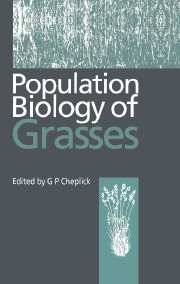Book contents
- Frontmatter
- Contents
- Contributors
- Preface
- Darwin revisited: approaches to the ecological study of grasses
- Part one Population variation and life history patterns
- 1 Allozyme diversity in the grasses
- 2 Ecology of seed dormancy and germination in grasses
- 3 Seed dispersal and seedling establishment in grass populations
- 4 Clonal biology of caespitose grasses
- 5 Ecological aspects of sex expression in grasses
- 6 Interspecific variation in plasticity of grasses in response to nitrogen supply
- 7 Population biology of intraspecific polyploidy in grasses
- Part two Ecological interactions
- Part three Population biology of specific groups
- Index
6 - Interspecific variation in plasticity of grasses in response to nitrogen supply
Published online by Cambridge University Press: 14 September 2009
- Frontmatter
- Contents
- Contributors
- Preface
- Darwin revisited: approaches to the ecological study of grasses
- Part one Population variation and life history patterns
- 1 Allozyme diversity in the grasses
- 2 Ecology of seed dormancy and germination in grasses
- 3 Seed dispersal and seedling establishment in grass populations
- 4 Clonal biology of caespitose grasses
- 5 Ecological aspects of sex expression in grasses
- 6 Interspecific variation in plasticity of grasses in response to nitrogen supply
- 7 Population biology of intraspecific polyploidy in grasses
- Part two Ecological interactions
- Part three Population biology of specific groups
- Index
Summary
Introduction
Over the last three decades, evidence has accumulated showing that plant species originating from nutrient-poor habitats tend to have a lower growth potential – i.e. when measured under optimal environmental conditions in the laboratory – than species from nutrient-rich habitats (e.g. Bradshaw et al., 1964; Grime & Hunt, 1975; reviews in Chapin, 1980,1988 and Lambers & Poorter, 1992). Whereas the adaptive value of a high growth potential is relatively clear, that of a low one has been the subject of much debate (Chapin, 1980,1988; Lambers & Dijkstra, 1987; Berendse & Elberse, 1990; Aerts & van der Peijl, 1993). One of the most convincing hypotheses currently put forward is that rather than the growth rate itself, it is one of its underlying components (namely the specific leaf area, the ratio of leaf area to leaf dry mass) which is the target of selection (Lambers & Dijkstra, 1987; Lambers & Poorter, 1992).
Species from habitats differing in fertility (or differing in growth potential) also exhibit differences in plasticity, defined as a variation in morphology and/or physiology in response to changes in environmental conditions (Schlichting, 1986). It has commonly been observed that the growth rate of species from nutrient-poor habitats (and slow-growing species) is less sensitive to a variation in external nutrient supply than that of species from nutrient-rich habitats (and fast-growing species: reviews in Chapin, 1980, 1988 and Lambers & Poorter, 1992). Furthermore, plants respond to nutrient stress by altering simultaneously a number of other traits: for example, when nitrogen availability decreases, internal plant nitrogen concentration decreases and biomass allocation to roots increases (both reviewed in Larsson, 1994).
- Type
- Chapter
- Information
- Population Biology of Grasses , pp. 155 - 182Publisher: Cambridge University PressPrint publication year: 1998
- 16
- Cited by



